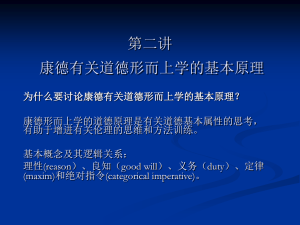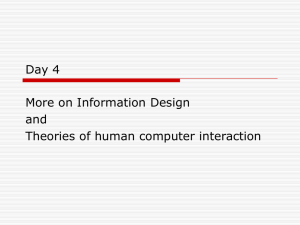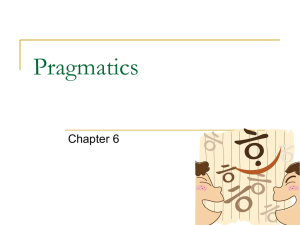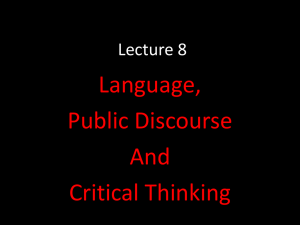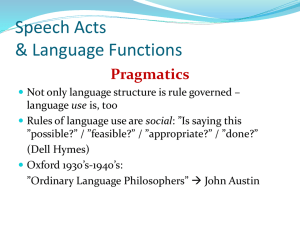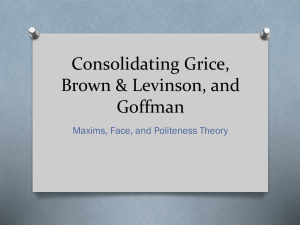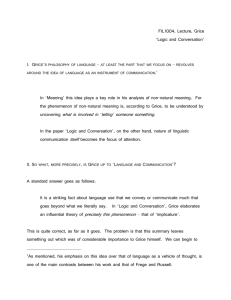Utterance Meaning
advertisement
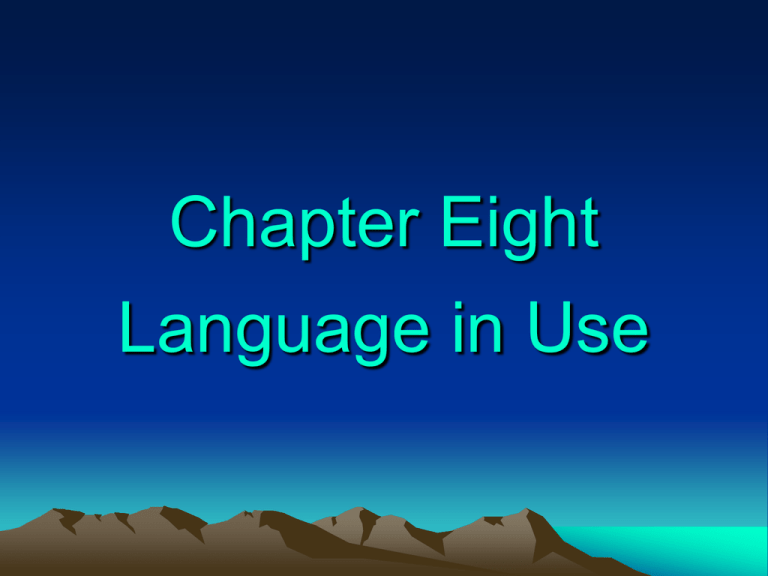
Chapter Eight
Language in Use
2
1. Definition of Pragmatics
• The study of language in use.
• The study of meaning in context.
• The study of speakers’ meaning,
utterance meaning,
& contextual meaning.
3
• Speaker’s meaning
(A father is trying to get his 3year-old daughter to stop lifting
up her dress to display her new
underwear to the assemble.)
– Father:
We don’t DO that.
– Daughter: I KNOW, Daddy.
You don’t WEAR
dresses.
4
• Utterance Meaning vs.
Sentence Meaning
• Utterance vs. Sentence
– Sentence: abstract units
of the language system.
– Utterance: units of
language in use.
5
• Sentence meaning: What does X mean?
• Utterance meaning: What do you mean
by X?
– Dog!
– My bag is heavy.
– “Janet! Donkeys!” (David Copperfield)
6
• It’s cold in here.
7
• Contextual Meaning: meaning in
context
– The meaning of the sentence depends
on who the speaker is , who the hearer
is, when and where it is used.
– It was a hot Christmas day so we went
down to the beach in the afternoon and
had a good time swimming and surfing.
8
• Semantic meaning: the more constant,
inherent side of meaning
• Pragmatic meaning: the more
indeterminate, the more closely related
to context
9
1. A: Are you going to the
seminar?
B: It’s on linguistics.
2. A: Would you like some
coffee?
B: Coffee would keep me
awake.
3. A: 我带的钱不够,今天买不了。
B: 那就下次再买吧。
10
2. Speech Act Theory
• John Austin (1911-1960)
• How to Do Things with
Words (1962)
• speech acts: actions
performed via utterances
11
• Constatives vs. performatives
• Constatives: utterances which roughly
serves to state a fact, report that
something is the case, or describe what
something is, eg:
– I go to the park every Sunday.
– I teach English.
12
• Performatives: utterances which are
used to perform acts, do not describe or
report anything at all; the uttering of the
sentence is the doing of an action; they
cannot be said to be true or false.
• Performative verbs: name, bet, etc.
13
• I do.
• I name this ship Queen
Elizabeth.
• I bet you sixpence it will rain
tomorrow.
• I give and bequeath my watch to
my brother.
• I promise to finish it in time.
• I apologize.
• I declare the meeting open.
• I warn you that the bull will
14
• Felicity conditions:
A. (i) There must be a relevant
conventional procedure.
(ii) the relevant participants and
circumstances must be appropriate.
B. The procedure must be executed
correctly and completely.
C. Very often, the relevant people must
have the requisite thoughts, feelings
and intentions, and must follow it up
with actions as specified.
15
• Problems with felicity conditions
– No strict procedure for promising.
– I promise.
– I give my word for it.
– I bequeath my watch to my brother. (T or F?)
16
• Minister: addressing the
groom)
(Groom’s Name), do you take
(Bride’s Name) for your lawful
wedded wife, to live together
after God’s ordinance, in the
holy estate of matrimony? Will
you love, honor, comfort, and
cherish her from this day
forward, forsaking all others,
keeping only unto her for as
long as you both shall live?
Groom:
I do.
17
• Features of performatives
• First person singular
• Speech act verbs / performative verbs:
– The present tense
– Indicative mood
– Active voice
18
• I promise to be there.
– I’ll be there.
• I admit I was wrong.
– I was foolish.
• I warn you, this gun is loaded.
– This gun is loaded.
• I thank you.
– I’m very grateful.
• I apologize.
– I’m sorry.
• I order you to sit down.
– You must sit down.
19
• Conclusion:
• The distinction between constatives &
performatives cannot be maintained.
• All sentences can be used to do things.
20
3. Illocutionary Act Theory
• John Searle (1932- )
• Speech acts can be
analyzed on 3 levels:
• A locutionary act: the act of
saying something in the full
sense of “say”.
21
• An illocutionary act: an act performed in
saying something. To say sth is to do sth.
– In saying X, I was doing Y.
– In saying “I will come tomorrow”, I was
making a promise.
• Illocutionary force
22
• A perlocutionary act: the act preformed
by or as a result of saying, the effects on
the hearer.
– By saying X and doing Y, I did Z.
– By saying “I will come tomorrow” and
making a promise, I reassure my friends.
– Shoot her!
23
4. Conversational Implicature
• People do not usually say
things directly but tend to
imply them.
• Herbert Paul Grice (1913-1988)
• William James lectures at
Harvard in 1967
• Logic and Conversation in
1975
24
• Grice’s theory Logic and Conversation is
an attempt at explaining how a hearer
gets from what is said to what is meant,
from the level of expressed meaning to
the level of implied meaning.
• The Cooperative Principle (CP)
25
• Make your contribution such as required
at the stage at which it occurs by the
accepted purpose or direction of the talk
exchange in which you are engaged.
26
• Maxim of Quality:
– Do not say what you believe to be false.
– Do not say something if you lack adequate
evidence;
• Maxim of Quantity:
– Make your contribution as informative as
required (for the current purposes of the
exchange).
– Do not make your contribution more
informative than required.
27
• Maxim of Relation: Be relative.
• Maxim of Manner: Be perspicuous.
– Avoid obscurity of expression.
– Avoid ambiguity.
– Be brief.
– Be orderly.
28
• CP is meant to describe what actually
happens in conversation.
• People tend to be cooperative and
obey CP in communication.
29
• However, CP is often violated.
– Since CP is regulative, CP can be violated.
• Violation of CP and its maxims leads to
conversational implicature.
30
Violation of the maxims
(Quantity)
1. Make your contribution as
informative as is required.
A: 昨天上街买了些什么?
B: 就买了些东西。
> I don’t want to tell you what I bought.
31
Dear Sir,
Mr. X’s command of English is excellent,
and his attendance at tutorials has been
regular.
Yours
> Mr. X is not suitable for the job.
32
2. Do not make your contribution more
informative than is required.
Aunt: How did Jimmy do his history
exam?
Mother: Oh, not at all well. Teachers asked
him things that happened before
the
poor boy was born.
> Her son should not be blamed.
33
A: Your kid broke the window.
B: Boys are boys.
>
War is war.
>
34
Violation of the maxims
(Quality)
1. Do not say what you
believe to be false.
• You are the cream in
my coffee.
• X runs as fast as a
deer.
• He is made of iron.
35
2. Do not say that for which you lack
adequate evidence.
A: Beirut is in Peru, isn’t it?
B: And Rome is in Romania, I suppose.
> It’s ridiculous.
36
Violation of the maxims
(Relation)
Be relevant.
A: Prof. Wang is an old bag.
B: Nice weather for the time of year.
> I don’t want to talk about Prof. Wang.
37
萍:爸爸,不过四凤同鲁贵在家里都很好,很
忠诚的。
朴:恩,我很累了。 我预备到书房歇一下。
你叫他们送一碗浓一点的普洱茶来。
>
38
Violation of the maxims
(Manner)
1. Avoid obscurity of expression
A: Let’s get the kids something.
B: Ok, but I veto C-H-O-C-O-L-A-T-E.
> Don’t give them chocolate.
39
2. Avoid ambiguity
A: Name and title, please?
B: John Smith, Associate Editor and
professor.
Cf:
买一赠一。
40
3. Be brief
A: Did you get my assignment?
B: I received two pages clipped together
and covered with rows of black
squiggles.
> not satisfied.
41
Characteristics of implicature
• Calculability: hearers work out
implicature based on literal meaning, CP
and its maxims, context, etc.
42
• Cancellability / defeasibility: If the
linguistic or situational contexts
changes, the implicature will also
change.
A: Do you want some coffee?
B: Coffee would keep me awake.
I do not like coffee.
B: Coffee would keep me awake. I want to
stay up.
43
• Non-detachability: implicature is attached
to the semantic content of what is said,
not to the linguistic form; implicatures do
not vanish if the words of an utterance
are changed for synonyms.
A: Shall we go the cinema tonight?
B: There’ll be an exam tomorrow.
I’ll take an exam tomorrow.
Isn’t there an exam tomorrow?
44
• Non-conventionality: implicature is
different from its conventional meaning of
words. It is context-dependent. It varies
with context.
A1:下午踢球去吧!
A2:老王住院了?
B:上午还在换草皮。
A3: 足球场安装了一个新门柱。
45
5. Politeness Principle
• Grice’s CP does not explain
why speakers often violate CP .
• Geoffrey Leech: Professor of
Linguistics and Modern
English Language at
Lancaster University from
1974 to 2002.
• Principles of Pragmatics
(1983): puts forward PP to
save CP.
46
A: We’ll miss Bill and Mary, won’t we?
B: Well, we’ll all miss Bill.
(violation of quantity maxim)
47
• Self(自身)----refers to the speaker.
• Other (他人)----refers to the addressee or
a third person, present or not.
• Benefit (惠) & Cost (损)
• Generally speaking, if there is benefit,
there must be cost.
48
• For some acts such as giving an
invitation, a piece of advice and an offer
are considered polite-natured, for other is
always on the beneficial side.
• For other acts like a request, an order and
a demand are considered impolitenatured, for other is always on the cost
side.
49
• Tact Maxim
• Generosity Maxim
• Approbation Maxim
• Modesty Maxim
• Agreement Maxim
• Sympathy Maxim
50
• Tact Maxim
a) Minimize cost to other
b) Maximize benefit to other ]
• Generosity Maxim
a) Minimize benefit to self
b) Maximize cost to self ]
51
• 把车借给我用两天。
• 洗一洗这些衣服。
• 把铅笔递一下。
• 再来一杯啤酒。
• 周末好好休息。
• 把房间打扫一下。
• 我想知道你是否有时间打扫
一下房间。
52
• Approbation Maxim
a) Minimize dispraise of
other
b) Maximize praise of other
• Modesty Maxim
a) Minimize praise of self
b) Maximize dispraise of self
53
A:我的西装怎么样?
B:难看死拉。
怎么说呢,不过我觉得颜
色深了点。
A:今天真倒霉!
B:我说的吧,自找的。
过去就算了,别再想拉。
54
• Agreement Maxim
a) Minimize disagreement
between self and other
b) Maximize agreement
between self and other
• Sympathy Maxim
a) Minimize antipathy
between self and other
b) Maximize sympathy
between self and other
55
A:我提议大家明天到江边烧烤。
B:我没意见。
可以,但风太大啊。
我不去,没意思。
A:我的腿不方便。
B:我知道,上次摔断了。
那小心点,我来吧。
56
6. Post-Gricean
Developments
• Relevance Theory:
– Dan Sperber (Jean Nicod Institute)
– Deirdre Wilson (UCL)
• The Q- and R-principles:
– Laurence Horn (Yale)
• The Q-, I- and M-principles:
– Stephen Levinson (Max Planck)
57
6.1 Relevance Theory
• 1986, 1995
• All Gricean maxims,
inc. the CP itself,
should be reduced to
a single principle of
relevance:
– ‘Every act of ostensive
communication
communicates the
presumption of its own
optimal relevance.’
58
• Ostensive communication:
– They agree with Grice that communication
is not simply a matter of encoding and
decoding, it also involves inference.
– But they maintain that inference has only to
do with the hearer. From the speaker's side,
communication should be seen as an act of
making clear one's intention to express
something. This act they call ostensive act.
In other words, a complete characterization
of communication is that it is ostensiveinferential.
59
• Presumption of optimal relevance:
– Initial version: An assumption is relevant
in a context if and only if it has some
contextual effect in that context.
• But what exactly is context?
– All the background info
– Sometimes some info must be excluded—
chosen relevance
– Generally the assumption people are
processing is relevant
60
• Revised version: An assumption is
relevant to an individual at a given time
if and only if it is relevant in one or
more of the contexts available to that
individual at that time.
– Relevance is not just a property of
assumptions in the mind, but also a
property of phenomena (stimuli, e.g.
utterances) in the environment which lead
to the construction of assumptions.
61
• A communicator cannot directly present an
audience with an assumption. All a speaker,
or a writer, can do is to present a stimulus
in the form of a sound, or a written mark.
• The presentation of this stimulus changes
the cognitive environment of the audience,
making certain facts manifest, or more
manifest.
• As a result, the audience can mentally
represent these facts as strong or stronger
assumptions, and even use them to derive
further assumptions.
62
• Final version: A phenomenon is
relevant to an individual if and only if
one or more of the assumptions it
makes manifest is relevant to him.
• Thus, by presumption of optimal
relevance is meant:
– The set of assumptions {I } which the
communicator intends to make manifest to
the addressee is relevant enough to make
it worth the addressee's while to process
the ostensive stimulus.
– The ostensive stimulus is the most
relevant one the communicator could have
used to communicate {I }.
63
• Every utterance comes with a
presumption of the best balance of effort
against effect.
– On the one hand, the effects achievable will
never be less than is needed to make it worth
processing.
– On the other hand, the effort required will
never be more than is needed to achieve
these effects. In comparison to the effects
achieved, the effort needed is always the
smallest.
• This amounts to saying “of all the
interpretations of the stimulus which
confirm the presumption, it is the first
interpretation to occur to the addressee
64
• George has a big cat.
• George has a tiger, a
lion, a jaguar, etc.
• George has a tiger.
• George has a tiger or a
lion, I'm not sure which.
• George has a felid.
65
• Second ed. (1995): two relevance-based
principles
• Communicative Principle of Relevance:
– Every act of ostensive communication
communicates the presumption of its own
optimal relevance.
• Cognitive Principle of Relevance:
– Human cognition tends to be geared to the
maximisation of relevance.
66
• The presumption of optimal relevance
is revised as follows:
– The ostensive stimulus is relevant enough
for it to be worth the addressee’s effort to
process it.
– The ostensive stimulus is the most
relevant one compatible with the
communicator’s abilities and preferences.
67
6.2 The Q- and R-principles
• Laurence Horn (1984):
– Toward a New Taxonomy for Pragmatic
Interface: Q-Based and R-Based
Implicature.
• Laurence Horn (1988):
– Pragmatic Theory.
68
• The Q-principle:
– The first of Grice's maxim of Quantity -Make your contribution as informative as
required (for the current purposes of the
exchange).
• The R-principle:
– The Maxim of Relation
• But the new principles are more
extensive than the Gricean maxims.
69
• The Q-principle (Hearer-based):
– MAKE YOUR CONTRIBUTION SUFFICIENT
(cf. Quantity1)
– SAY AS MUCH AS YOU CAN (given R)
• The R-principle (Speaker-based):
– MAKE YOUR CONTRIBUTION NECESSARY
(cf. Relation, Quantity2, Manner)
– SAY NO MORE THAN YOU MUST (given Q)
70
• The hearer-based Q-principle
is a sufficiency condition in
the sense that information
provided is the most the
speaker is able to.
• For example, (a) below
implicates (b):
– (a) Some of my friends are
linguists.
– (b) Not all of my friends are
linguists.
71
• The R-principle encourages the hearer
to infer that more is meant. Typical
examples are speech acts like:
– Can you pass the salt?
72
• The Q-principle is concerned with the
content.
– The speaker who follows this principle
supplies the sufficient information.
• The R-principle is concerned with the
form.
– The speaker who employs this principle
uses the minimal form, so that the hearer
is entitled to infer that the speaker means
more than he says.
73
• Example: negation usually means ‘less
than’.
– He didn't eat three carrots.
– He ate less than three carrots.
• Metalinguistic negation:
– He didn't eat THREE carrots.
– He ate FOUR of them.
– You didn't eat SOME of the cookies—
you ate ALL of them.
– It isn't POSSIBLE she'll win—it's
CERTAIN she will.
74
• I didn't break a
finger yesterday.
• I broke a finger, but
it wasn't one of
mine. (Q-based)
• I broke a finger
yesterday.
• I broke a finger of
mine yesterday.
(R-based)
75
• John had a drink.
• The secretary smiled.
• John had an alcoholic
drink.
• The female secretary
smiled.
• John didn't have a drink—
that was a Shirley Temple.
• *My secretary didn't
smile—I have a male
secretary.
76
• Horn argues that this exception is more
apparent than real.
– Both speakers' intuition and
lexicographers' practice suggest that the
implicature associated with drink, i.e.
“alcoholic drink”, has become part of the
conventional meaning, while that of
secretary, i.e. “female secretary” has not.
– In other words, the interpretation of drink
in the sense of “alcoholic drink” is no
longer an implicature.
77
• Synonym avoidance:
– There are many terms formed with the
adjective pale and colour words, such as,
pale green, pale blue, pale yellow, but pale
red sounds odd.
– This oddity may be attributed to the
existence of the word pink.
– Unless one wants to designate a colour
which is paler than red, but not yet as pale
as pink, the term pale red would not be
used.
– Because of the existence of pink the use
of pale red is limited in a way that pale
blue and pale green are not.
78
• Black Bart
killed the
sheriff.
• Black Bart
caused the
sheriff to die.
• Lee stopped
the car.
• Lee got the
car to stop.
79
• Horn observes that the Q-based and Rbased principles often directly collide.
– “A speaker obeying only Q would tend to
say everything she knows on the offchance that it might prove informative,
while a speaker obeying only R would
probably, to be on the safe side, not open
her mouth. In fact, many of the maxim
clashes Grice and others have discussed
do involve Quantity1 vs. Relation”.
80
• But “it is perhaps in the resolution of
the conflict between them that they
play their major role”.
• He suggests this resolution comes
from a division of pragmatic labour as
follows:
– The use of a marked (relatively complex
and/or prolix) expression when a
corresponding unmarked (simpler, less
“effortful”) alternate expression is
available tends to be interpreted as
conveying a marked message (one which
the unmarked alternative would not or
could not have conveyed).
81
6.3 The Q-, I- and M-principles
• Stephen Levinson (1987):
– Pragmatics and the Grammar of
Anaphor: A Partial Pragmatic
Reduction of Binding and Control
Phenomena
• Stephen Levinson (1989):
– Review of Relevance by Sperber
and Wilson
82
• The Q-, I- and M-principles are Grice's
two maxims of Quantity and a maxim of
Manner reinterpreted neo-classically.
– The maxims of Quality, as is the case in
Horn's theory, are kept intact.
– Levinson does not agree with the
treatment in both Sperber & Wilson's and
Horn's accounts to subsume the second
maxim of Quantity under a principle of
relevance, or relation.
83
• In his view, the maxims of Quantity
have to do with the quantity of
information, while
– relevance is a measure of timely
helpfulness with respect to interactional
goals, and
– is largely about the satisfaction of others'
goals in interaction, and the satisfaction of
topical and sequencing constraints in
discourse, as in the expectation that an
answer will follow a question.
84
• It is not, at least not primarily, about
information.
– So he renames the second maxim of
Quantity the Principle of Informativeness,
or I-Principle;
– and the first maxim of Quantity the
Principle of Quantity, or Q-Principle.
85
• The M-principle:
• Levinson mixes the presentation of his
own ideas with the criticism of Horn's
principles.
• He accuses Horn of failing to draw a
distinction between two kinds of
minimization:
– a semantic minimization and
– an expression minimization.
86
• The semantic, or content, minimization
is equivalent to semantic generality:
– the more general terms are more minimal
in meaning, having more restricted
connotation (in contrast to the more
extended denotation); and
– the less general, the more specific, are
less minimal, more maximal.
• For example, ship is more general than
ferry, flower than rose, animal than tiger.
– The choice of the former instead of the
latter is a process toward minimization.
87
• The expression, or form, minimization is
some measure of surface length and
complexity.
– It is concerned with the phonetic and
morphological make-up of a term.
– The normally stressed terms are more
minimal than their abnormally stressed
counterparts.
– The shorter terms are more minimal than
longer ones, provided they are
synonymous, such as frequent and not
infrequent, to stop a car and to cause a car
to stop.
88
• Only the semantic minimization has to
do with the I-principle.
• The expression minimization, in
contrast, is the domain of the principle
of manner, as it concerns the form of a
linguistic unit, the way to express
something rather than what is
expressed, or how much is expressed.
89
• Recently, Levinson calls his principles
“heuristics”.
• Levinson (2000): Presumptive Meaning.
MIT.
– Heuristic 1. What isn’t said, isn’t.
– Heuristic 2. What is simply described is
stereotypically exemplified.
– Heuristic 3. What’s said in an abnormal
way, isn’t normal; or Marked message
indicates marked situation.
90
• Heuristic 1: Q-Heuristic
• “more or less transparently related to
Grice’s first Maxim of Quantity”
• Responsible for two types of
implicatures: scalar implicatures and
clausal implicatures
– Some of the boys came. (scalar)
– Not all the boys came.
– If eating eggs is bad for you, you should
give up omelets. (clausal)
– Eating eggs may be bad for you, or
it may not be bad for you.
91
• Scalar implicatures are the implicatures
which involve the Q-principle in Horn’s
sense.
– Words like all and some form a scalar
contrast set <all, some>, in which all is the
more informative, or stronger, term, and
some the less informative, or weaker, term.
92
• Clausal implicatures involve the use of
different clauses.
– Since eating eggs is bad for you, you
should give up omelets.
– Eating eggs may be bad for you, or it may
not be bad for you.
93
• Two clausal alternates:
– If eating eggs is bad for you, you should
give up omelets.
– Since eating eggs is bad for you, you
should give up omelets.
• which may be expressed as
– <(since p, q), (if p, q)>
• The clause using since is the more
informative, or stronger, alternate, and
the one using if the less informative, or
weaker, alternate.
94
• Heuristic 2: I-Heurisitc
• “may be related directly to Grice’s second
Maxim of Quantity, ... The underlying idea
is, of course, that one need not say what
can be taken for granted”.
(a) John turned the key and the engine started.
(b) John turned the key, and then the engine
started.
John turned the key, therefore the engine
started.
John turned the key in order to start the 95
(a) If you mow the lawn, I'll give you $5.
(b) If and only if you mow the lawn, I'll
give you $5.
(a) John unpacked the picnic. The beer
was warm.
(b) The beer was part of the picnic.
(a) John said “Hello” to the secretary and
then he smiled.
(b) John said “Hello” to the female
secretary and then John smiled.
96
(a) Harry and Sue bought
a piano.
(b) They bought it
together, not one
each.
(a) John came in and he sat down.
(b) John1 came in and he1 sat down.
97
• Heuristic 3: M-Heuristic
– can be related directly to Grice’s maxim of
Manner (‘Be perspicuous’), specifically to
his first submaxim ‘avoid obscurity of
expression’ and his fourth ‘avoid
prolixity’...
• The underlying idea here is that there is
an implicit opposition or parasitic
relationship between our second and
third heuristics:
– what is said simply, briefly, in an unmarked
way picks up the stereotypical
interpretation;
– if in contrast a marked expression is used,
98
it is suggested that the stereotypical
• Thus, (a) below should be interpreted in
the stereotypical way by the I-Heuristic,
say the probability is n, then (b) should
be interpreted in the marked way by the
M-Heuristic, i.e., the probability is less
than n.
– (a) It’s possible that the plane will be late.
– (b) It’s not impossible that the plane will be
late.
99
• In the same way, the use of a longer
alternative to a simple causative verb
suggests some deviation from the
normal situation.
– Bill stopped the car.
– Bill did it in the stereotypical manner with
the foot pedal.
– Bill caused the car to stop.
– Bill did it indirectly, not in the normal way,
e.g., by the use of the emergency brake.
100
• If the speaker uses a marked
expression the man instead of an
unmarked expression he, then John
and the man will not be coreferential.
– John came in and the man laughed.
• There is still a long way to go before we
find a solution to all the problems we
have in the study of language in use,
and there are new attempts to improve
on all these principles.
101
